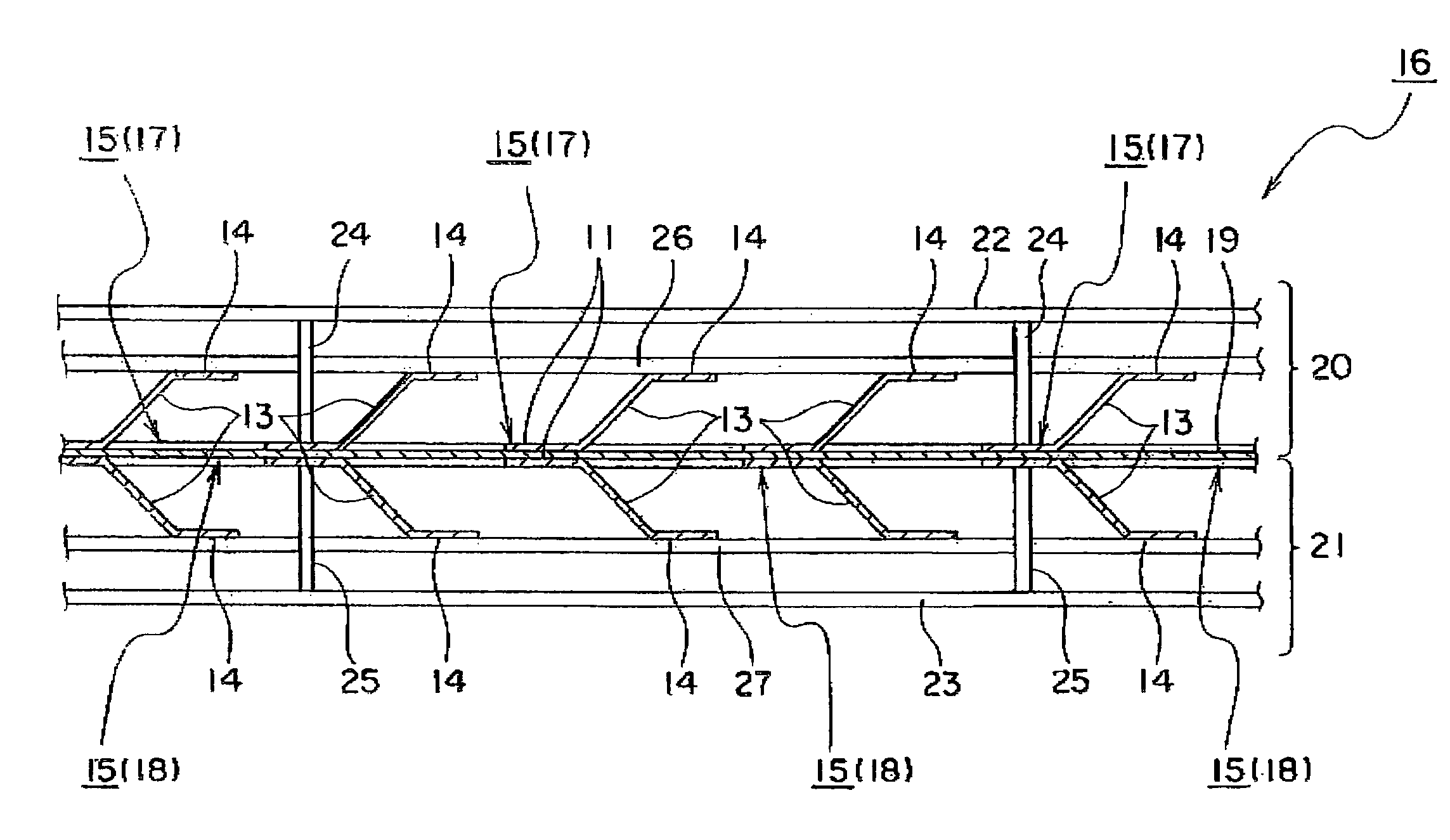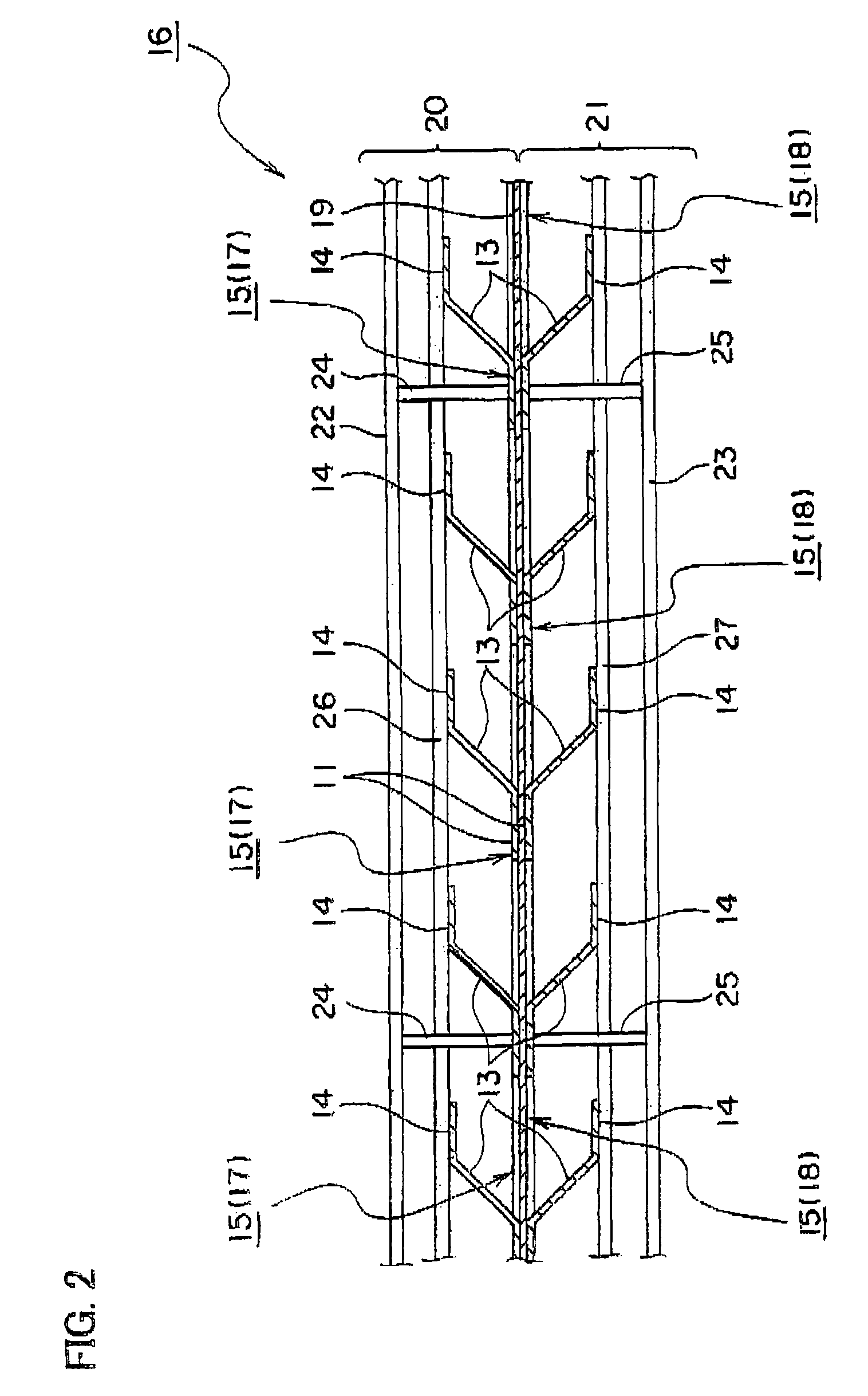Three-dimensional electrode for electrolysis, ion exchange membrane electrolytic cell and method of electrolysis using three-dimensional electrode
a three-dimensional electrode and electrolysis technology, applied in the direction of electrolysis components, electrolysis processes, electrolysis organic production, etc., can solve the problems of unsatisfactory energy saving to this extent, the cost of energy or electric power occupies about half of the total manufacture cost, etc., to achieve higher strength, higher toughness, and higher strength
- Summary
- Abstract
- Description
- Claims
- Application Information
AI Technical Summary
Benefits of technology
Problems solved by technology
Method used
Image
Examples
example 1
[0088]A unit ion exchange membrane electrolytic cell was assembled as follows.
[0089]A dimensionally stable electrode (DSE) for brine electrolysis having an effective electrode area of 1540 cm2 (width of 11 cm×height of 140 cm) and requiring a lower amount of oxygen available from Permelec Electrode, Ltd. was used as an anode. The anode was welded to an anode chamber partition wall by using an anode rib.
[0090]An expanded metal cathode current collector prepared by electroless-plating nickel on copper alloy and further plating Raney nickel catalyst thereon in dispersion state was mounted on a cathode chamber partition wall by using a cathode rib made of plate-like nickel.
[0091]A copper alloy plate having length of 110 mm, width of 350 mm and thickness of 0.2 mm was used as an electrode substrate of a three-dimensional electrode unit. After the copper alloy plate was shaped to expanded metal, snicks having breadth of 2 mm and length of 9 mm were formed in 36 rows each having six pieces...
example 2
[0097]An anode and an anode chamber were the same as those of Example 1.
[0098]An expanded metal cathode current collector made of nickel was mounted on a cathode chamber partition wall by using a cathode rib made of plate-like nickel.
[0099]A nickel plate having length of 110 mm, width of 350 mm and thickness of 0.2 mm was used as an electrode substrate of a three-dimensional electrode unit. After the nickel plate was shaped to expanded metal, snicks having breadth of 2 mm and length of 9 mm were formed in 36 rows each having six pieces with a pitch of 5 mm by using the press working.
[0100]Thereafter, the nickel plate was plated with Raney nickel catalyst by using nickel in the dispersion state, thereby supporting electrode catalyst thereon.
[0101]Then, each of the snicks was bent toward the same direction at an angle of 45 degree to form an elastic electroconductive section, and the front end thereof was bent so as to be parallel to the electrode substrate, thereby providing the thre...
example 3
[0105]A unit ion exchange membrane electrolytic cell was assembled as follows.
[0106]A cathode was prepared by plating Raney nickel catalyst on expanded metal made of nickel in dispersion state for supporting the catalyst thereon. The effective area of the cathode was 1540 cm2 (width of 11 cm×height of 140 cm). The cathode was mounted on a cathode chamber partition wall of the electrolytic cell by using a cathode rib.
[0107]An expanded metal anode current collector made of titanium was mounted on an anode chamber partition wall by using an anode rib made of plate-like titanium.
[0108]A titanium plate having length of 110 mm, width of 350 mm and thickness of 0.5 mm was used as an electrode substrate of a three-dimensional electrode unit. After the titanium plate was shaped to expanded metal, snicks having breadth of 2 mm and length of 9 mm were formed in 36 rows each having six pieces with a pitch of 5 mm by using the press working.
[0109]Thereafter, RuO2—Ti2O-based catalyst was supporte...
PUM
| Property | Measurement | Unit |
|---|---|---|
| concentration | aaaaa | aaaaa |
| diameter | aaaaa | aaaaa |
| bending angle | aaaaa | aaaaa |
Abstract
Description
Claims
Application Information
 Login to View More
Login to View More - R&D
- Intellectual Property
- Life Sciences
- Materials
- Tech Scout
- Unparalleled Data Quality
- Higher Quality Content
- 60% Fewer Hallucinations
Browse by: Latest US Patents, China's latest patents, Technical Efficacy Thesaurus, Application Domain, Technology Topic, Popular Technical Reports.
© 2025 PatSnap. All rights reserved.Legal|Privacy policy|Modern Slavery Act Transparency Statement|Sitemap|About US| Contact US: help@patsnap.com



